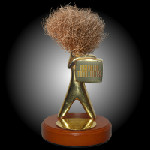Vale Mad as Hell season 6
What is there to say as we wave goodbye to another year of Mad as Hell that we haven’t said at least four times before? Much as we’d prefer to have Micallef end each season with a Charlie Pickering-like threat of a guaranteed return, the fact that each series of Mad as Hell could be our last reminds us that all joy in this life is fleeting… especially if you’re expecting to find that joy in Australian comedy.
Sure, this season was consistent; they’re all consistent. So was Newstopia in its own, live-audience-free way before that. While Micallef is a man of many talents and interests – we hope you’ve already booked your ticket to see him and Francis Greenslade on stage in The Odd Couple in Melbourne later this year, because last time we checked they were all but sold out – it seems that desk-bound news comedy (with the occasional sketch thrown in) is the groove he’s most comfortably settled into. Especially after the first season of The Ex PM took more time to click than a six part series can afford.
It’s also a format that allows him to do his style of comedy while seemingly making a show that fans of The Project can get on board with. A lot of Micallef and his team’s comedy is weird in a way that can be alienating if you don’t get the reference (seriously, though, if you’ve the slightest interest in pop culture, you’ll get the reference): presenting it in a format that anyone who’s ever looked at a television set is completely comfortable with goes a long way towards explaining why we’ve been able to have five seasons of a show featuring a Kraken trapped inside a high school locker.
Still, one of the complaints we heard a few times during this season of Mad as Hell was that Micallef and company were falling back on in-jokes and old references just a little bit too often. Surely bringing back Milo Kerrigan, even in cameo form, is going to be confusing to anyone not intimately familiar with the ins and out of Micallef’s long television career? And what’s with dusting off the old Micallef Tonight sign?
We have two replies, so feel free to pick the one you like best. Is it:
A): Mad as Hell is by its very nature a show jam-packed with pop culture references. It’s a lot more likely that audiences in 2016 are going to get a reference to a much-loved Micallef comedy character from the 90s than they are, say, the Manchurian Candidate (1963 version) reference from last episode.
or,
B): Television in the 21st century is a medium struggling with dwindling audiences. In a world where more people remember Milo Kerrigan than are actually watching Mad as Hell now, doesn’t it make sense for Micallef to reference his past as much as possible? Nostalgia is what keeps people watching Australian television; the ratings that doomed Micallef Tonight are higher than what Mad as Hell pulls in now.
Personally? We love Mad as Hell not just because it contains jokes – and there we go again with our insane pro-joke stance, when are we finally going to realise that the future of comedy lies with shows that are basically just shit drama series – but because it’s a show that manages to be both traditional (sketches! Reoccurring characters!) and the future of comedy television.
Look, no-one in television has any money, least of all for comedy, even more least of all for comedy that can’t be sold overseas. And as has been obvious for the last decade or so, when you don’t have enough money to make a proper television show you make a show that involves people sitting around talking. Which is what around 70% of Mad as Hell is – and more than half of that 70% on an average episode is just Micallef talking to camera.
So why does it work when The Weekly doesn’t? Because it has a funny host – and by “host” we mean “skilled comedic performer playing the role of host” – and writers willing to revel in a joke. Rather than bringing in a big team of writers to punch out a whole bunch of snappy gags, Mad as Hell will occasionally let a bit run and run before getting to a punchline. A lot of Micallef’s speeches wander all over the place and expect you to keep up to get the laugh, and then there’ll be a bunch of quick photo gags or an observation that could have come from The Chaser or The Weekly. Only it wouldn’t have worked as well on those shows, because that’s the only note those shows offer while Mad as Hell is hitting all eight and the half notes in between.
It might be using a tried-and-true-and-cheap format, but Mad as Hell mixes things up. It doesn’t fall into the trap of making the exact same kinds of jokes over and over for half an hour. That’s the only way you can make a show that’s largely a man behind a desk talking to camera consistently fresh and funny. That’s why Mad as Hell is the most important comedy on Australian television: it’s the only one doing this kind of thing right.
